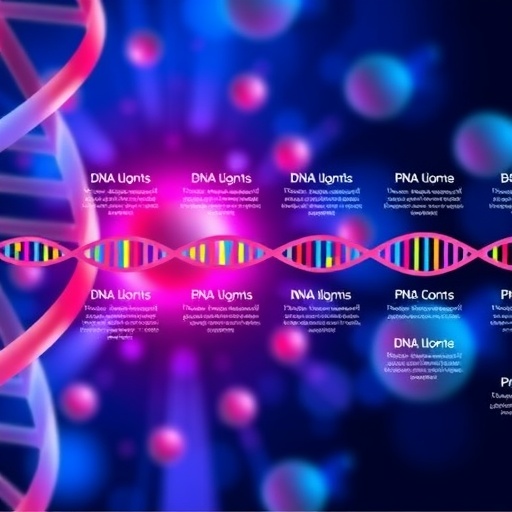A groundbreaking study published in the prestigious journal Nature Genetics has unveiled an unprecedented timeline of DNA damage events that occur during the development of multiple myeloma, a malignant blood cancer ranking as the second most common hematologic malignancy worldwide. By decoding the intricate genomic evolution of this disease, researchers have opened new avenues for refining patient stratification and tailoring treatment approaches based on the temporal emergence of critical genetic alterations.
Multiple myeloma’s pathogenesis is notoriously complex, evolving through a prolonged asymptomatic phase known as monoclonal gammopathy of undetermined significance (MGUS), followed by smoldering myeloma before culminating in symptomatic disease. Historically, understanding the precise sequence and timing of genomic changes that underlie this progression has been challenging. However, the latest research has shed light on how DNA damage accumulates over decades, predating clinical diagnosis by an astonishing 20 to 40 years. This extended preclinical phase reveals potential windows for early detection and intervention.
Central to the study’s approach was leveraging a rich dataset comprising 421 whole-genome sequences obtained from tumor samples of 382 multiple myeloma patients. These samples primarily represented newly diagnosed cases, though some included longitudinal data after therapeutic interventions. To reconstruct the chronological order of mutational events within these mature tumors, the researchers applied an advanced computational framework known as the molecular time model. This model deciphers the relative timing of genomic aberrations by quantifying benign point mutations—mutations that accumulate at a predictable rate and do not contribute to tumorigenesis per se, but serve as molecular timestamps.
.adsslot_eFsUGLx1B5{width:728px !important;height:90px !important;}
@media(max-width:1199px){ .adsslot_eFsUGLx1B5{width:468px !important;height:60px !important;}
}
@media(max-width:767px){ .adsslot_eFsUGLx1B5{width:320px !important;height:50px !important;}
}
ADVERTISEMENT
The molecular time model hinges on the principle that DNA within cells accrues point mutations at a relatively constant pace over time. When a chromosome undergoes duplication—a hallmark in multiple myeloma evolution—it brings with it a baseline level of benign mutations. Over ensuing years, post-duplication, the additional copies accumulate unique mutations independently. Measuring the disparity in these mutation burdens allows researchers to estimate when specific chromosomal duplications or structural rearrangements occurred in the patient’s life, effectively creating a chronological map of tumor evolution.
One of the pivotal insights from this analysis was the reaffirmation and refinement of the concept of hyperdiploidy as an early genomic event in a subset of patients. Hyperdiploidy, characterized by the gain of multiple chromosomes, was consistently preceded by a translocation involving the immunoglobulin heavy chain (IGH) locus. This canonical IGH translocation event emerged as a key initiating genetic aberration in approximately 10% of cases, dictating the subsequent genomic landscape and influencing disease trajectory.
Furthermore, the study unveiled the clinical significance of a specific alteration—the gain of the long arm of chromosome 1, commonly referred to as chr 1q gain. Notably, patients who acquired this aberration early in their disease process exhibited significantly worse clinical outcomes compared to those in whom it occurred later. This temporal distinction positions chr 1q gain not only as a marker of disease aggressiveness but also as a potential prognostic indicator that reflects the evolutionary stage of tumor development rather than merely its presence or absence.
Interestingly, the research also implicated treatment-mediated selective pressures in shaping the genomic architecture, particularly in relation to chr 1q gain following exposure to melphalan, a chemotherapeutic agent frequently employed before stem cell transplantation. This finding suggests that therapy-induced genotoxic stress can accelerate or modulate the acquisition of specific mutations, complicating disease evolution and treatment response.
The implications of these findings extend far beyond mapping mutational sequences. They highlight the intrinsic heterogeneity of multiple myeloma at both a biological and temporal level, underscoring the importance of integrating timing information into clinical paradigms. By understanding not only which genetic events occur but precisely when they transpire along the disease continuum, clinicians may one day refine prognostication and tailor therapies that target vulnerabilities unique to each phase of tumor evolution.
Moreover, the molecular time model demonstrates the feasibility of transforming complex genomic data into clinically relevant timelines. While still in the research arena, there is a compelling vision to adapt this model for routine clinical use. Envisioned applications include estimating patient survival more accurately based on mutational chronology or predicting the emergence of treatment resistance by tracking mutational dynamics over time.
Beyond the immediate clinical translations, this study prompts fundamental questions for future inquiry. For instance, how do early DNA damage events influence the accrual and nature of subsequent mutations? Are there additional genomic markers with similarly impactful temporal characteristics awaiting discovery? Could early intervention during the protracted latent phase of multiple myeloma alter disease trajectory or even prevent progression? These questions set the stage for a new era of precision oncology driven by temporal genomics.
The multi-institutional collaboration among centers known for their expertise in computational biology and genomics— including the Sylvester Comprehensive Cancer Center at the University of Miami, Memorial Sloan Kettering Cancer Center, and the German Cancer Research Center—was instrumental in achieving these insights. The integration of large-scale whole-genome sequencing with sophisticated molecular modeling underscores the power of interdisciplinary research in unraveling cancer’s intricate biology.
In essence, the study by Kaddoura, Landgren, Diamond, and colleagues marks a significant leap forward in the understanding of multiple myeloma’s evolutionary timeline. It highlights that the tumor’s genomic identity is shaped not only by the events themselves but also by their sequence and timing, an often-overlooked dimension with profound therapeutic implications. As precision medicine continues to advance, incorporating the “when” alongside the “what” in genetic alterations promises to redefine patient care.
For more updates on this topic and Sylvester Comprehensive Cancer Center’s pioneering research, the InventUM blog and their social media channels offer ongoing coverage. This evolving narrative of temporal genomics brings hope that future myeloma therapies will be more personalized, effective, and timely, ultimately improving patient outcomes in this challenging malignancy.
Subject of Research: Temporal genomic dynamics and DNA damage timeline in multiple myeloma
Article Title: Temporal genomic dynamics shape clinical trajectory in multiple myeloma
News Publication Date: August 20, 2025
Web References:
https://www.nature.com/articles/s41588-025-02292-1
https://news.med.miami.edu/multiple-myelomas-timeline-revealed/
References: DOI: 10.1038/s41588-025-02292-1
Image Credits: Photo by Sylvester Comprehensive Cancer Center
Keywords: Multiple myeloma, cancer, blood cancer, myeloma, genomic DNA, genome sequencing
Tags: asymptomatic phase of multiple myelomaDNA damage timeline in multiple myelomaearly detection of multiple myelomagenetic alterations in multiple myelomagenomic evolution of blood cancerlong-term accumulation of DNA damagemonoclonal gammopathy of undetermined significancemultiple myeloma pathogenesisNature Genetics study on multiple myelomapatient stratification in cancer treatmenttherapeutic interventions for blood cancerwhole-genome sequencing in cancer research





